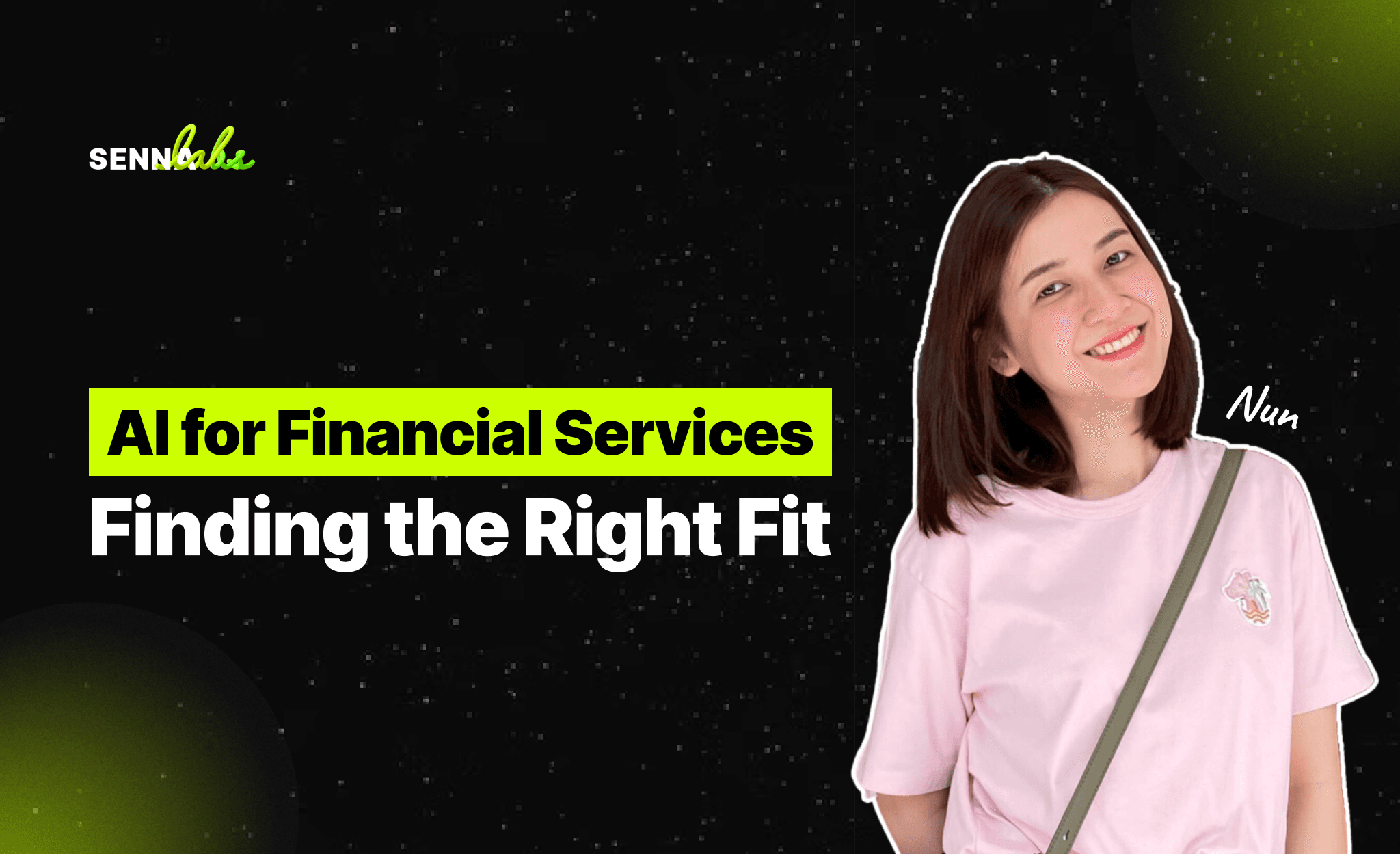AI for Financial Services: Finding the Right Fit
Share

The financial services industry is undergoing a technological revolution, with Artificial Intelligence (AI) playing a pivotal role in enhancing operations, improving customer service, and mitigating risks. From detecting fraudulent transactions to offering personalized banking experiences, AI tools are helping financial institutions stay competitive and secure.
This article explores how financial organizations can choose the right AI tools, focusing on a use case where a bank adopts an AI-driven fraud detection system to monitor transactions in real-time.

Why AI is Critical for Financial Services
AI brings transformative benefits to the financial sector:
-
Fraud Detection: AI algorithms analyze transaction patterns to identify and prevent fraudulent activities in real time.
-
Risk Analysis: Predictive analytics assess risks for lending, investments, and compliance.
-
Customer Service: AI-powered chatbots provide 24/7 support and personalized recommendations.
-
Operational Efficiency: Automating routine tasks like document processing reduces costs and human error.
-
Regulatory Compliance: AI ensures adherence to complex financial regulations by monitoring and flagging irregularities.
Example: A bank uses AI to flag suspicious transactions based on abnormal patterns, preventing significant financial losses.
Key Features to Look for in AI Tools for Financial Services
1. Fraud Detection and Prevention
AI tools for fraud detection analyze large volumes of data to detect anomalies and potential threats.
-
Key Features:
-
Real-time transaction monitoring
-
Behavioral analytics to identify unusual activities
-
Machine learning models that improve over time
-
Examples: Tools like Feedzai and Fraud.net specialize in real-time fraud detection.
2. Risk Analysis
AI helps financial institutions assess and mitigate risks efficiently.
-
Key Features:
-
Predictive analytics for credit scoring and loan approvals
-
Stress testing for investment portfolios
-
Automated compliance checks
-
Examples: Zest AI for credit underwriting and SAS Risk Management for advanced risk analytics.
3. Customer Service
AI-powered tools enhance customer interactions by providing instant support and tailored financial advice.
-
Key Features:
-
Chatbots with natural language processing (NLP)
-
Personalized product recommendations based on customer behavior
-
Voice recognition for secure and convenient interactions
-
Examples: Chatbot platforms like Kasisto and virtual assistants like Amelia.
4. Data Security and Privacy
Financial data is highly sensitive, and AI tools must ensure robust protection.
-
Key Features:
-
End-to-end encryption
-
Anonymization of customer data
-
Adherence to regulatory standards like GDPR and CCPA
-
Examples: Tools like Palantir and Darktrace focus on cybersecurity and data protection.
How to Choose the Right AI Tool for Financial Services
Step 1: Define Your Objectives
Identify the specific challenges your organization wants to address with AI:
-
Fraud Prevention: Reducing fraudulent activities and financial losses.
-
Customer Engagement: Enhancing customer satisfaction and retention.
-
Operational Efficiency: Streamlining processes like loan approvals or compliance checks.
Example: A bank prioritizes fraud detection to protect its customers and assets.
Step 2: Assess Your Data Readiness
AI relies on high-quality data to deliver accurate insights. Evaluate:
-
Data Volume: Ensure sufficient historical and real-time data for training AI models.
-
Data Quality: Check for completeness, consistency, and accuracy.
-
Data Integration: Confirm that the AI tool can connect with your existing systems, such as core banking platforms.
Example: The bank integrates transaction data from its payment processing system into the AI tool.
Step 3: Evaluate AI Providers
Research and compare AI tools based on your needs:
-
Functionality: Does the tool address your specific objectives, such as fraud prevention or risk analysis?
-
Scalability: Can the AI system grow with your organization’s expanding data and needs?
-
Ease of Use: Is the platform user-friendly, or does it require extensive training?
-
Support: Does the vendor offer strong customer support and training resources?
Example: The bank evaluates Feedzai for its real-time fraud detection capabilities and scalability.
Step 4: Run a Pilot Program
Test the AI tool on a small scale before full implementation:
-
Select a Test Environment: Use a subset of transaction data or a specific business unit for testing.
-
Monitor Performance: Evaluate metrics like fraud detection accuracy, false positives, and processing speed.
-
Collect Feedback: Involve key stakeholders, such as fraud analysts and IT teams, to assess usability and effectiveness.
Example: The bank runs a three-month pilot program, achieving a 40% reduction in undetected fraud.
Step 5: Monitor and Optimize the AI Tool
Once implemented, continuously monitor the AI’s performance and make improvements:
-
Track KPIs: Measure accuracy, efficiency, and ROI.
-
Update Models: Use new data to retrain and refine AI algorithms.
-
Expand Usage: Scale the AI tool to additional areas, such as risk analysis or customer engagement.
Example: The bank expands the AI tool to include predictive credit risk assessments after its success in fraud detection.
Benefits of AI in Financial Services
-
Enhanced Security: Real-time fraud detection protects customers and the organization.
-
Improved Decision-Making: AI provides actionable insights for risk management and investments.
-
Operational Efficiency: Automation reduces processing times and costs.
-
Customer Satisfaction: Personalized services and faster responses improve customer loyalty.
-
Regulatory Compliance: AI ensures adherence to financial regulations, reducing penalties and risks.
Challenges and Solutions
Challenge 1: High Implementation Costs
Solution: Start with scalable tools or pilot programs to demonstrate ROI.
Challenge 2: Data Privacy Concerns
Solution: Select AI providers with robust encryption and regulatory compliance.
Challenge 3: Resistance to Adoption
Solution: Provide training and highlight how AI complements human expertise.
The Future of AI in Financial Services
As AI technology advances, its applications in financial services will expand:
-
Hyper-Personalization: AI will create even more tailored financial products and recommendations.
-
Predictive Compliance: Tools will proactively identify regulatory risks before they escalate.
-
Autonomous Banking: AI-driven systems will handle end-to-end customer interactions with minimal human intervention.
-
Blockchain Integration: AI will enhance the security and efficiency of blockchain-based financial transactions.
Conclusion
AI is transforming financial services by enabling fraud prevention, risk analysis, and customer engagement. Selecting the right AI tool involves defining objectives, assessing data readiness, and running pilot programs to ensure alignment with business goals.
For the bank deploying an AI-driven fraud detection system, the benefits are clear: enhanced security, reduced losses, and improved customer trust. As AI continues to evolve, it will become an indispensable tool for financial organizations, driving innovation and efficiency in a dynamic industry.

Share

Keep me postedto follow product news, latest in technology, solutions, and updates
Related articles
Explore all


